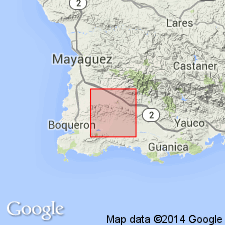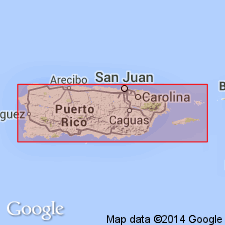
- Usage in publication:
-
- Jicara Formation*
- Modifications:
-
- Revised
Summary:
The Jicara Formation is here revised and accepted for USGS usage. Disconformably overlies the El Rayo Formation. A lens of bioclastic limestone below the thin-bedded volcanic siltstone and mudstone formerly considered to be a basal unit of the Jicara is here moved to the El Rayo because it contains rudist fragments characteristic of the El Rayo and has identical lithology. Age of the Jicara is early Eocene based on Foraminifera.
Source: GNU records (USGS DDS-6; Reston GNULEX).

- Usage in publication:
-
- Jicara Formation*
- Modifications:
-
- Age modified
- AAPG geologic province:
-
- Caribbean region
Summary:
The Jicara Formation occurs in southwestern Puerto Rico and consists of laminated tuff with a conchoidal fracture (composed of pale-green glass shards, quartz crystal fragments, and rare pyroxene and plagioclase crystal fragments. Maximum thickness is 1000 meters. The age of the Jicara is changed to late Paleocene and early Eocene.
Source: GNU records (USGS DDS-6; Reston GNULEX).
For more information, please contact Nancy Stamm, Geologic Names Committee Secretary.
Asterisk (*) indicates published by U.S. Geological Survey authors.
"No current usage" (†) implies that a name has been abandoned or has fallen into disuse. Former usage and, if known, replacement name given in parentheses ( ).
Slash (/) indicates name conflicts with nomenclatural guidelines (CSN, 1933; ACSN, 1961, 1970; NACSN, 1983, 2005, 2021). May be explained within brackets ([ ]).

